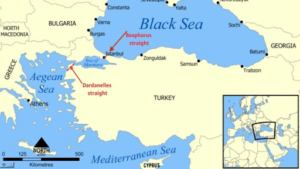In news– Amidst Russia-Ukraine war, Turkey is activating the Montreux Convention on naval passage through two of its strategic straits, which would allow them to limit the movement of Russian warships between the Mediterranean Sea and the Black Sea.
What is the Montreux Convention?
- The Montreux Convention Regarding the Regime of the Straits(1936), often referred to simply as the Montreux convention is an agreement concerning both the Bosporus and Dardanelles straits.
- It was signed on 20 July 1936 at the Montreux Palace in Switzerland.
- It addressed the long-running Straits Question over who should control the strategically vital link between the Black and Mediterranean Seas.
- In response to Turkey’s request to refortify the area, the signers of the Treaty of Lausanne and others met in Montreux and agreed to return the zone to Turkish military control.
- It guarantees complete freedom of passage for all civilian vessels during peacetime and permits Turkey to restrict the passage of navies not belonging to Black Sea states.
- In the event of a war, the pact gives Turkey the right to regulate the transit of naval warships and to block the straits to warships belonging to the countries involved in the conflict and to permit merchant ships free passage.
- Article 19 of the treaty contains an exception for the countries on the Black Sea that can effectively undermine Turkey’s power in blocking the Russian warships entering or exiting the Black Sea: which means warships can return to their original bases through the passage and Turkey cannot prevent it.
About Turkish Straits-
- The Bosporus and Dardanelles straits, also known as the Turkish Straits or the Black Sea Straits, connect the Aegean Sea and the Black Sea via the Sea of Marmara.
- It is the only passage through which the Black Sea ports can access the Mediterranean and beyond.

- Over three million barrels of oil, about three per cent of the daily global supply, mostly produced in Russia, Azerbaijan, and Kazakhstan, pass through this waterway every day.
- The route also ships large amounts of iron, steel, and agricultural products from the Black Sea coast to Europe and the rest of the world.
















